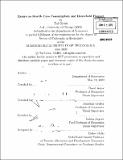| dc.contributor.advisor | David Autor, Jonathan Gruber and Joshua Angrist. | en_US |
| dc.contributor.author | Gross, Tal (Tal A.) | en_US |
| dc.contributor.other | Massachusetts Institute of Technology. Dept. of Economics. | en_US |
| dc.date.accessioned | 2009-11-06T16:22:40Z | |
| dc.date.available | 2009-11-06T16:22:40Z | |
| dc.date.copyright | 2009 | en_US |
| dc.date.issued | 2009 | en_US |
| dc.identifier.uri | http://hdl.handle.net/1721.1/49705 | |
| dc.description | Thesis (Ph. D.)--Massachusetts Institute of Technology, Dept. of Economics, 2009. | en_US |
| dc.description | Includes bibliographical references (p. 107-111). | en_US |
| dc.description.abstract | This thesis explores how health insurance affects the decisions that individuals make. The first chapter studies the effect of insurance on health care consumption. Nearly 10 percent of teenagers become ineligible for their families' health insurance coverage on their nineteenth birthdays. Due to the federal Emergency Medical Treatment and Active Labor Act, however, they do not lose access to free emergency room care. I develop a straightforward theoretical framework to understand the implications of insurance transitions at age nineteen. I then develop an empirical framework that exploits the discontinuity in health insurance at age nineteen. Using a unique database of 15 million hospital discharge records, I find that Emergency Room (ER) usage rises discontinuously at age nineteen, particularly for minorities and residents of low-income zip codes. As predicted by the theoretical framework, the jump in ER utilization at age nineteen is disproportionately driven by ailments that physicians classify as inappropriate for ER care. I also find suggestive evidence that health care expenditures outside of the ER decline. A large share of the increase in ER utilization at age nineteen takes the form of uncompensated care, the cost of which is born by third parties. These findings constitute some of the first evidence on how the incentives faced by the uninsured affect medical expenditure. The second chapter, written jointly with Matthew Notowidigdo, studies the contribution of medical costs in the decision to declare bankruptcy. Consumer bankruptcies increased eighty-seven percent in the 1990s. | en_US |
| dc.description.abstract | (cont.) By the end of the decade, more than one percent of American households were declaring bankruptcy in any given year. Anecdotal evidence and several observational studies suggest that out-of-pocket medical costs are pivotal in a large fraction of consumer bankruptcy declarations. In this paper, we use variation in Medicaid eligibility to assess the contribution of medical costs to household bankruptcy risk. Using cross-state variation in Medicaid expansions from 1992 through 2002, we find that a 10 percentage point increase in Medicaid eligibility reduces the personal bankruptcy rate by 8.7 percent, with no evidence that business bankruptcies are similarly affected. We interpret our findings with a model in which health insurance substitutes for other forms of financial protection. We conclude with a calibration exercise that suggests that out-of-pocket medical costs are pivotal in roughly 26 percent of personal bankruptcies among low-income households. The third chapter studies how transitions in insurance status may affect the consumption of health care. Transitions from one insurance program to another-or from insured status to uninsured status-are common. How these transitions affect individuals depends, in part, on whether consumers anticipate the loss of insurance. Potentially, if consumers are sufficiently forward-looking, they may "stock up" on health care before losing coverage. | en_US |
| dc.description.abstract | (cont.) This paper studies the transition in insurance status as teenagers move from their family's coverage to uninsured status or other insurance plans. I find no evidence that teenagers stock up on medical care before coverage ends, but rather a general decrease in health care consumption in the last month of coverage. | en_US |
| dc.description.statementofresponsibility | by Tal Gross. | en_US |
| dc.format.extent | 111 p. | en_US |
| dc.language.iso | eng | en_US |
| dc.publisher | Massachusetts Institute of Technology | en_US |
| dc.rights | M.I.T. theses are protected by
copyright. They may be viewed from this source for any purpose, but
reproduction or distribution in any format is prohibited without written
permission. See provided URL for inquiries about permission. | en_US |
| dc.rights.uri | http://dspace.mit.edu/handle/1721.1/7582 | en_US |
| dc.subject | Economics. | en_US |
| dc.title | Essays on health care consumption and household finance | en_US |
| dc.type | Thesis | en_US |
| dc.description.degree | Ph.D. | en_US |
| dc.contributor.department | Massachusetts Institute of Technology. Department of Economics | |
| dc.identifier.oclc | 436448383 | en_US |
